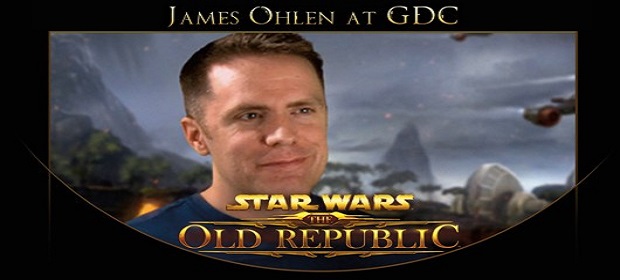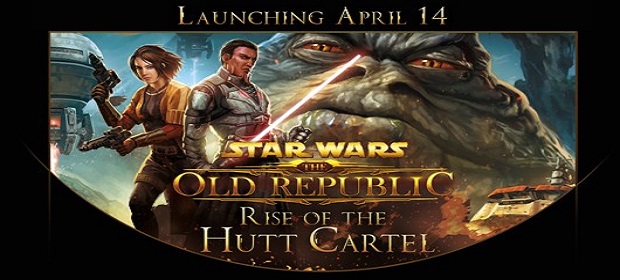Your login information returned multiple users. Please select the user you would like to log in as and re-type in your password.

Star Wars: The Old Republic has been on something of a roller coaster ride ever since its launch over a year ago. What started off as one of the most successful launches to an MMO soon declined and saw a massive drop off in subscription numbers. Bioware/EA had to switch SWTOR's business model to the F2P system that now sustains most MMOs on the market. James Ohlen, the Creative Director of SWTOR, attended GDC to talk about Bioware's first MMO and Massively gave out the details from the presentation.
Possibly the most surprising thing about the presentation, was James Ohlen dispelling what has long since, apparently, been a misconception about SWTOR's budget. Since Bioware had set out to give their MMO as many unique voice actors as possible, everyone had always assumed that is where most of the game's budget went towards. Ohlen, however, stated that Bioware has had a long history with voice actors, even though this was a different branch of developers, and the cost spent on recording voice work did not exceed expectations. The major costs actually came from QA testing and SWTOR's engine itself.
This being Bioware's first MMO, they had no pre-tested engine on which to base their game off of. The team decided to turn towards the Hero Engine which, at that time, had only been used for a single game which was created by the developers of the Hero Engine itself. Bioware needed 300 people working simultaneously on what was practically an untested engine which certainly could not have been cheap. On top of that, Bioware wanted to make storytelling an integral part of MMOs which involved not only adding a more in depth narrative, but also creating dialogue choices and decisions similar to those found in Mass Effect. These decisions added even more variables that would need to be tested, ensuring the cost of QA testing would also continue to rise as the game progressed. In closing this part of his presentation, Ohlen gave some advice to the audience:
"Don't be scared about adding voice over and cool cinematic content, but do be careful about adding lots of choice with consequence because that adds to QA cost and development cost and makes it hard to design everything."

Despite being such an important figure for SWTOR, James Ohlen did not try to skirt around the game's issues at launch. One of the key things he noted was that he felt SWTOR's end game just wasn't ready. Not only was the game lacking some key social features that made group finding easier, but they also did not have as many end game Operations (Raids) as they would have liked and key Guild features had also yet to be implemented. Bioware was aware of these issues, but were lax in addressing them because they thought they had more than enough time to get around to them.
Based on metrics gathered by the SWTOR team, they had expected players to reach the end game content about 3 to 4 months post launch. This may seem like a ridiculous thing to expect, but the game was also filled with cutscenes and dialogue not present in other MMOs at the time. Essentially, Bioware expected players to take their time and enjoy the questing they had spent so long developing; which all added up to about 180 hours of content for a first playthrough. Unfortunately for the SWTOR team, that wasn't the case at all. Post launch, their metrics showed that players were absolutely destroying their content at a rate of about 40 hours a week. After the first month of the game's launch, half a million players had reached the end game and were unsatisfied.
This was the point things started to go downhill for The Old Republic and Bioware-Austin. While the dev team was able to eventually implement all of the key features missing from the game's launch, it came too late and players were still leaving in droves. Ohlen specifically stated that the Summer after SWTOR's launch was the low point not only for the game, but the studio as well. Some of you may recall this being the time Bioware-Austin was hit with rounds of lay offs and, to top it all off, Biwoare's co-founders had resigned from the company. Guild Wars 2 being launched in August with Mists of Pandaria just around the corner all but crushed the dev team's hope of maintaining what was supposed to be the last great subscription MMO.

So, Bioware made the move to make SWTOR F2P; however, Ohlen stated that the game was made to be a subscription based game and they were determined on keeping subscribers as the central focus. Bioware also realized they needed to still draw in new players, so the Cartel Market was added. This cash shop not only allowed F2P players to pick and choose what “subscriber” features to unlock, but also allowed the purchase of item packs that provide random loot; all of which can be traded or sold to other players. All of this was a success for SWTOR once the F2P model launched in November. Subscription numbers and concurrent players both skyrocketed with 2 million new accounts created since November. Ohlen stated that SWTOR is now the second biggest Western developed subscription MMO and is one of the most lucrative microtransaction games for EA.
With this turn around, Bioware-Austin is now capable of making strides forward from here on out. They are currently getting ready to release their first expansion for SWTOR and introduce items “that do not exist in current MMOs”. The morale for Bioware only continued to climb once the studio had been informed they would head all EA MMOs in the future that do not just pertain to the Star Wars IP. Back when Bioware was given the choice to make an MMO, they had narrowed down their decision to two IPs: Star Wars or Game of Thrones. At that time, the team had chosen to move forwad with Star Wars, but, who knows, maybe now we'll get to see that Game of Thrones MMO.




Comments
12 years, 3 months ago
I've played about 30 levels of TOR and honestly while I am sure those are all reasons for why it didn't do well, the fact that it is the same and rather tired idea of how to make an MMO when people really just wanted a KoToR 3 ever since the launch of the 360 are bigger reasons. It was never going to be a leader in the MMO space by following someone else's lead.